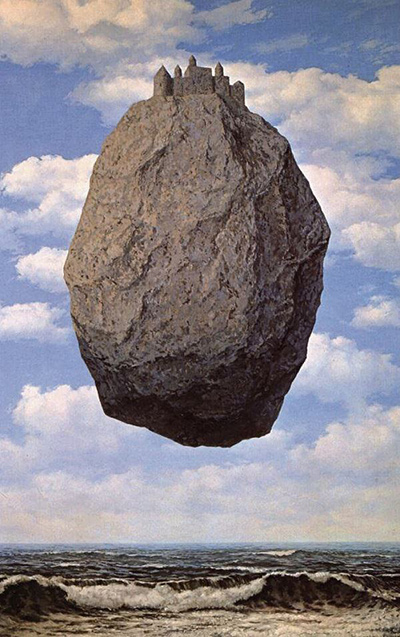René Magritte was a Belgian artist whose works fall under the genre of surrealism. He was quite popular during his lifetime and was known for portraying everyday ideas and objects in surprisingly different ways that got attention. He was a big influence on pop art in the 20th century.
Le Château des Pyrénées depicts a single huge rock suspended in space far above the ocean. On top of this rock is a castle with fortified walls. The blue sky in the background is covered with puffy clouds. It appears to be a nice day for a suspended rock with a castle on top! Harry Torczyner, a lawyer, a poet and an author, was a friend of Magritte. He commissioned Magritte to do a painting for him, which is documented in letters. Through them, we know that Magritte and Torczyner discussed the theme of the painting in detail before Magritte settled on the castle. Magritte presented several rough sketches to Torczyner as a proposal, from which Torczyner selected one. He also made the suggestion of the rough, churning ocean and the clear sky, which the artist implemented in his work. The title is given based on a book of the same name by Jostein Gaarder.
The beauty of Le Château des Pyrénées is that it depicts both heaviness and lightness in the same piece of art. The rock, which is supposed to be heavy and immovable is floating in the air, and is being depicted as a light and buoyant object. The situation is impossible in reality, and is what gives a surrealist feel to the painting. But because of the clarity of its depiction and the complete lack of detail in the background, the picture has a photographic feel to it, which renders it believable. The art might refer to themes of isolation, loneliness, detachment, and escape. The painting was completed in 1959 and is currently held in Jerusalem at the Israel Museum. Magritte also made two more copies of Le Château des Pyrénées with minor changes in the details, mainly playing around with the ocean below and making it calmer. This painting is considered Magritte's masterpiece and is one of his most frequently reproduced work. And no wonder, it is a fascinating piece of art!
Magritte worked with other painting techniques until 1926, when he created his first surrealist painting called, The Lost Jockey. Before this, he had dabbled with Impressionism, Cubism, and Futurism. His surrealist art, for which he is the most known, were heavily influenced by the French artist, André Breton, and the British artist, Edward James. In turn, he has influenced a generation of artists such as John Baldessari, Ed Ruscha, Jan Verdoodt, Martin Kippenberger, and Storm Thorgerson. Born in 1898 in Hainaut, Belgium, much of Magritte's early life is not documented. One of the few things known about him is that his drawing lessons started in 1910, and that he began painting from the age of 15 in 1913. The artist studied art at the Académie Royale des Beaux-Arts in Brussels with Constant Montald as this instructor. The Second World War affected him as he was forced to serve in the army.
The war also affected him in other ways. There was no work for him after the war, and he was reduced to painting fakes of popular Picassos, Braques and Chiricos, a pitiful occupation for a brilliant artist! He even ventured into printing forged banknotes during this period as a desperate measure. Some of the more popular paintings by René Magritte are The Treachery of Images, The Enchanted Pose, The Adulation of Space, and The Empty Mask. The Castle Of The Pyrenees also proved to be quite popular. The original title for it is Le Château des Pyrénées. This work is very typical of Magritte's art and is one of his best known artworks.




